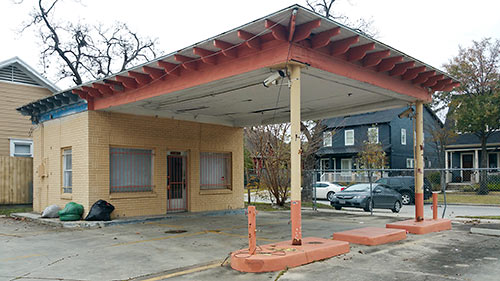
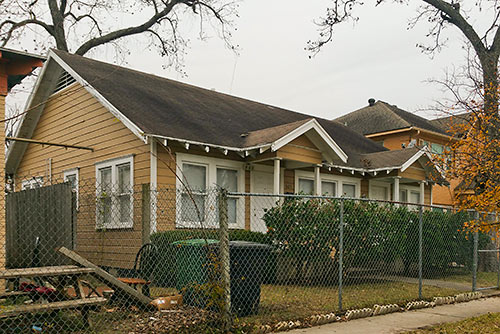
The owner of this 1930-ish former gas station and duplex bungalow at 3500 White Oak Dr. in the Houston Heights Historic District South plans to tear down the 2 structures and build a single-family home on the 8,800-sq.-ft. site — likely facing the side street, Cortlandt. Last week by a vote of 12 to 6 Houston’s planning commission reversed the decision of the archaeological and historic commission, allowing the demo to go through. The HAHC had denied the owner’s demolition request in November, insisting that the structures could be rehabbed. But experts hired by the owner indicated that the underground gas tank beneath the station couldn’t be removed without demolishing that structure, and that redevelopment of the duplex would be “cost prohibitive.”


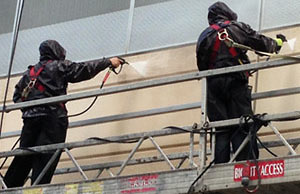 When was the last time anyone bothered to clean the exterior of the Astrodome? Long enough ago to merit
When was the last time anyone bothered to clean the exterior of the Astrodome? Long enough ago to merit 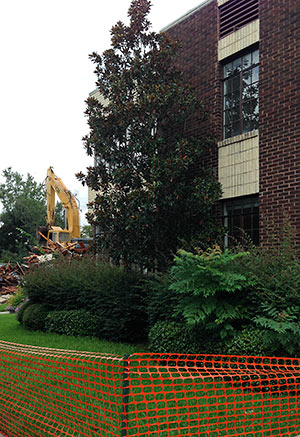 Demolition crews turned the Josephine Apartments into a dusty pile of rubble yesterday (as seen in Swamplot’s on-the-spot
Demolition crews turned the Josephine Apartments into a dusty pile of rubble yesterday (as seen in Swamplot’s on-the-spot 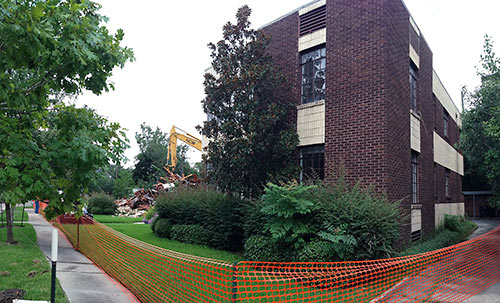
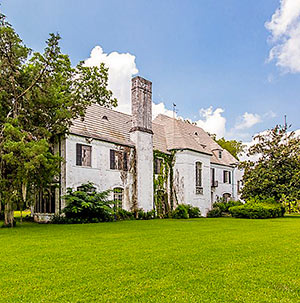 The owner of a offshore-drilling-rig fabricating company in Baytown and his wife, a real estate agent, have bought the former Weingarten mansion at 4000 S. MacGregor Way in Riverside Terrace —Â and they’re announcing plans to restore the property with the help of architect David Bucek, whose firm was responsible for the
The owner of a offshore-drilling-rig fabricating company in Baytown and his wife, a real estate agent, have bought the former Weingarten mansion at 4000 S. MacGregor Way in Riverside Terrace — and they’re announcing plans to restore the property with the help of architect David Bucek, whose firm was responsible for the  “Southern Pacific (not Union Pacific, as one writer claimed), demolished this station in 1959. Critics may blame Houstonians for failing to rally and save the building, but the fact is that the modern architectural preservation movement didn’t start until the early 1970s, and even my architecturally hip home town of Chicago let some classic beauties like Louis Sullivan’s Stock Exchange slip away before public sentiment for preservation began to build. The first downtown railroad-station preservation-restoration project did not take place until 1973, when the Southern Railway’s vacant Terminal Station in Chattanooga was transformed into a restaurant and hotel complex.
If anybody has any photos of the interior of the SP station in Houston I would like to examine them for a book I’m writing about what happened to each of the big downtown stations in North America. SP’s Houston Station was designed by Texas’s most celebrated architect, Wyatt C. Hedrick, who also designed the Shamrock Hotel, the T&P station in Fort Worth, and dozens of admired hotels, factories and commercial buildings. Photos of his T&P station are all over the Internet but SP demolished his Houston station before anyone had a chance to make any good photos.” [
“Southern Pacific (not Union Pacific, as one writer claimed), demolished this station in 1959. Critics may blame Houstonians for failing to rally and save the building, but the fact is that the modern architectural preservation movement didn’t start until the early 1970s, and even my architecturally hip home town of Chicago let some classic beauties like Louis Sullivan’s Stock Exchange slip away before public sentiment for preservation began to build. The first downtown railroad-station preservation-restoration project did not take place until 1973, when the Southern Railway’s vacant Terminal Station in Chattanooga was transformed into a restaurant and hotel complex.
If anybody has any photos of the interior of the SP station in Houston I would like to examine them for a book I’m writing about what happened to each of the big downtown stations in North America. SP’s Houston Station was designed by Texas’s most celebrated architect, Wyatt C. Hedrick, who also designed the Shamrock Hotel, the T&P station in Fort Worth, and dozens of admired hotels, factories and commercial buildings. Photos of his T&P station are all over the Internet but SP demolished his Houston station before anyone had a chance to make any good photos.” [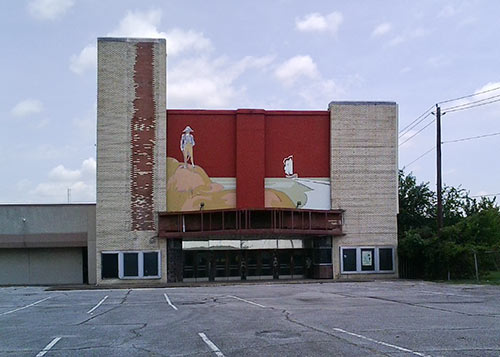

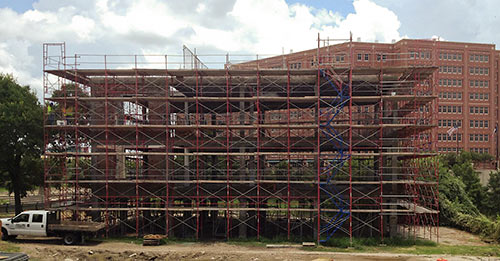
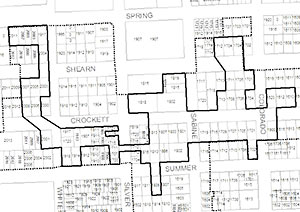 The High First Ward is the newest historic district in Houston, having been voted in by a 12-5 count of city council members this afternoon. The stringy selection of 55 lots (pictured at right),
The High First Ward is the newest historic district in Houston, having been voted in by a 12-5 count of city council members this afternoon. The stringy selection of 55 lots (pictured at right),  Responding to months of community pressure and protests, postal service officials today reversed course from an earlier announcement and said
Responding to months of community pressure and protests, postal service officials today reversed course from an earlier announcement and said 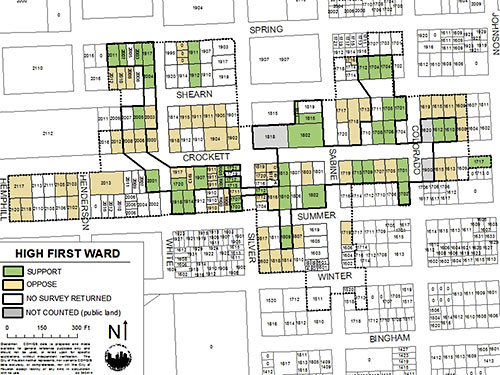
 “. . . The loss of historic architecture does not mean that the area is no longer historic; however, signs could be posted that say something to the effect of, “this historic area used to contain significant architecture that was so undervalued that it was demolished to make way for new, soon to be historic architecture.†[
“. . . The loss of historic architecture does not mean that the area is no longer historic; however, signs could be posted that say something to the effect of, “this historic area used to contain significant architecture that was so undervalued that it was demolished to make way for new, soon to be historic architecture.†[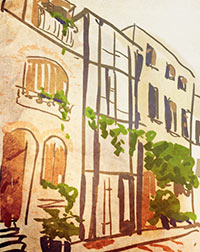 “There’s good and bad in historic preservation. The best historic preservation differentiates between neighborhoods and buildings. At the neighborhood level, there are strict strict controls on lot subdivision, building heights, setbacks, tree preservation, and sidewalks – so that new construction fits in the urban fabric. In Paris, France, you can design a totally new and modern building on a boulevard, as long as it continues the street wall and meets the mansard roof setbacks of its neighbors. (At least, it’s how it was 20 years ago when I was studying architecture in Paris.)
For certain historic buildings, there are strict requirements for style and color and all of that. But it doesn’t extend through the whole historical neighborhood. Unfortunately, the differentiation seems lost here in the States. In other cities (New York in particular) they strictly control the details of any building that gets built in a historical district. It’s a real pain in the ass for the architects, and expensive for the owners.” [
“There’s good and bad in historic preservation. The best historic preservation differentiates between neighborhoods and buildings. At the neighborhood level, there are strict strict controls on lot subdivision, building heights, setbacks, tree preservation, and sidewalks – so that new construction fits in the urban fabric. In Paris, France, you can design a totally new and modern building on a boulevard, as long as it continues the street wall and meets the mansard roof setbacks of its neighbors. (At least, it’s how it was 20 years ago when I was studying architecture in Paris.)
For certain historic buildings, there are strict requirements for style and color and all of that. But it doesn’t extend through the whole historical neighborhood. Unfortunately, the differentiation seems lost here in the States. In other cities (New York in particular) they strictly control the details of any building that gets built in a historical district. It’s a real pain in the ass for the architects, and expensive for the owners.” [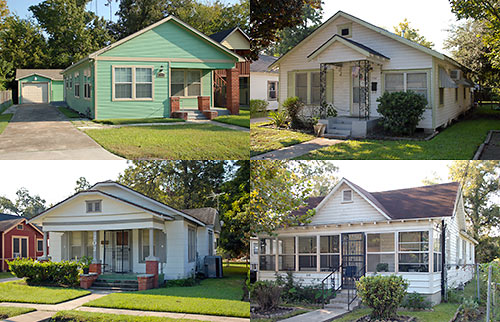
 Psssssssst! Don’t tell anyone, but the Astrodome was
Psssssssst! Don’t tell anyone, but the Astrodome was